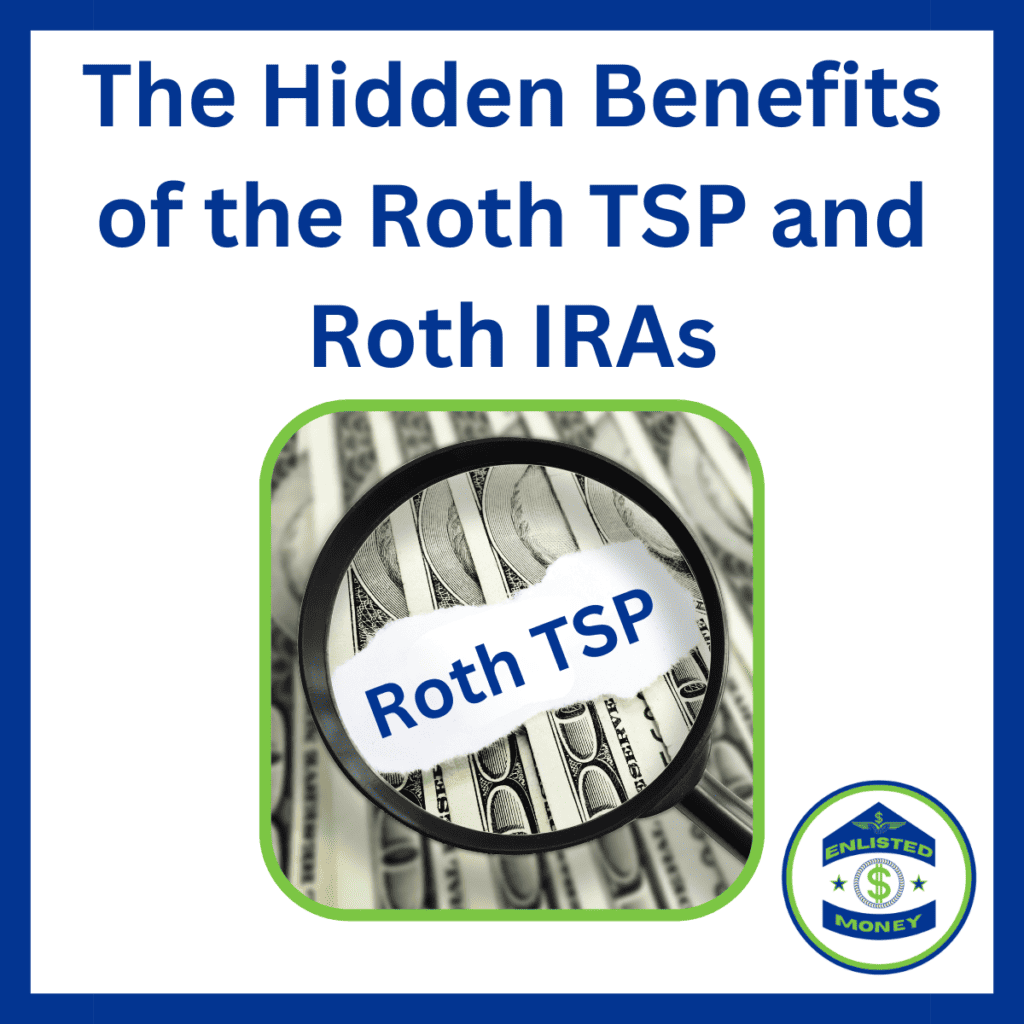
The “traditional” arguments on Roth versus traditional miss so much. I’m hoping to go beyond the typical “taxes now versus taxes later” argument to help you decide what’s best for you. (Hint: Probably Roth.)
Enlisted service members in particular have some unique advantages making the Roth Thrift Savings Plan (TSP) or Roth IRA the best default choice. I know having a lower income doesn’t seem like an advantage, but your high percentage of non-taxable income is.
Basic Differences Between Roth and Traditional Accounts
Just as a refresher, the difference in Roth versus traditional starts when you pay taxes. When you contribute to a traditional retirement account such as the traditional TSP, a 401(k), or IRA, you get a deduction from your taxable income now. You contribute before taxes, then withdraw those funds in retirement where that money is taxed as ordinary income.
Roth accounts work the opposite. You pay taxes first, contribute to the Roth TSP or Roth IRA after tax, then withdraw these funds tax-free in retirement.
Simple… or is it?
It feels like just a simple question of timing and tax brackets. Do you pay taxes now or later? Will I be in a higher tax bracket now or later? This could seem like a toss-up – not so fast.
The Overlooked Advantages of Roth Versus Traditional
Withdrawals from your traditional TSP, IRA, or 401k are reported as taxable, ordinary income in retirement. This can push you into higher tax brackets, cause more of your Social Security benefits to be taxed, and other issues.
One of the most overlooked advantages of distributions from your Roth TSP, Roth IRAs, and other Roth accounts is their exclusion from your income in retirement. As long as you make a qualified distribution (after age 59-1/2, 5-year rules, etc.), the money you pull from your Roth accounts will not be included in your adjusted gross income (AGI) or modified adjusted gross income (MAGI). This is huge when it comes to your overall tax liabilities, benefits, and expenses.
Effects on Social Security
Before you start down the path of “Social Security won’t be there for me,” please understand, it will still be there in some form until the year 2097 or longer. There’s a very high likelihood you’ll get something from Social Security.
Taxation of Social Security Benefits
The threshold at which your Social Security benefits will be subject to tax is actually quite low. I know, it might seem silly to tax your Social Security, but this is just the way it’s worked since 1984.
By having your retirement savings in a Roth account, you’ll have a much easier time staying under these thresholds and avoid having as much of your Social Security retirement benefits taxed.
Avoid Raising Medicare Premiums
When you’re withdrawing from Roth accounts, the Roth income won’t cause you to incur income-related monthly adjustment amounts (IRMAAs) which raise your Medicare premiums. I understand the thresholds for IRMAAs may seem high, but it is a consideration.
Eliminate Required Minimum Distributions (RMDs)
RMDs essentially force you to start drawing funds from your retirement accounts whether you need to or not. This can cause you to have more taxable income than you need and cause your overall tax rate to be higher. With the passing of SECURE 2.0, all Roth accounts, including the Roth TSP, are exempt from RMDs.
What You See is What You Get
My favorite benefit of having money in Roth accounts is the guaranteed money (no taxes withheld) you’ll get from Roth distributions. If you have $500,000 in a Roth account, you have $500,000. Money in a traditional account is still subject to taxes, so the amount you can actually use is much less.
This also insulates you from changes to tax rates in the future. If tax rates go up, you can sleep easy knowing your retirement accounts aren’t going to be affected. On the flip side, if tax rates go down (doesn’t seem likely) there is some risk you already paid taxes at a higher rate. However, there’s just no way to know until it’s too late to make a change anyway.
No matter what, when I think about the future, I personally want a guaranteed income. I have absolutely no clue what tax brackets will look like when I retire. As long as I have all my retirement money in Roth accounts, I’ll care a lot less.
Get More into Your TSP with Your Roth Account
Note: This example was contributed by Sam Lewis, CFP®, ChFC®, founder and lead planner of SJL Financial, LLC.
If you’re a super saver and can bear the taxes now, you can have more value in your TSP by maxing out your contributions with your Roth TSP. This is because the taxes have already been paid with Roth accounts – there will be no reduction for taxes later.
Example: A Tale of Two Sergeants
Sergeant A contributes the maximum to their traditional TSP in 2023 ($22,500) with tax-deferred contributions and Sergeant B also maxes out their contributions ($22,500) but to their Roth TSP. They both make the same investment decisions and have the same return outcomes (balances are equal when it’s time to withdraw).
Since Sergeant A will owe taxes on the withdrawal of those funds, they have less “real” value than the same amount in a Roth account. Sergeant A only saved about $2,700 in Federal taxes this year (12% bracket), but Sergeant B was willing to eat that tax bill today to get more after-tax money into his Roth TSP to have tax-free funds in the future.
Other Benefits of Roth Accounts
In addition to all the benefits I mentioned, your ability to keep your taxable income low may help you qualify for other income-related benefits. Many government programs and all income taxation are based on your taxable income level. Keeping your AGI low can also help you qualify for lower capital gains taxes too.
When Roth Might Not Be Best
There are some cases where it could make sense to use a traditional retirement account to lower your taxable income now. This isn’t a complete list, just a few I think you might encounter.
- Dual Military/Dual Income Families
- Reducing Expected Family Contribution Calculations for Student Aid
- Student Loan Payments/Public Service Loan Forgiveness (PSLF)
- Receiving Bonuses, Special Pay, and Allowances
Just remember, if you need to lower your AGI or taxable income for a particular year or time frame, contributing to a traditional TSP can help. In general, the threshold you want to look at is when your total monthly taxable pay is getting above $9,762.50 per month for couples or $4,881.25 filing single1. This keeps your income within the 10 and 12% tax brackets for the year.
In other words, a good rule of thumb (as of 2023) is if you have an average of $10,000 (Married) or $5,000 (single) or less in taxable monthly income (exclude BAH and BAS), Roth is probably the way to go without question.
Wrapping Up the Roth Discussion
Once you consider the massive benefit of excluding Roth withdrawals from your income in retirement, I feel Roth is the way to go for many enlisted service members, including me. With our low taxable income compared to our total “usable” compensation, being in historically lower tax brackets, and the uncertain future of tax rates, Roth accounts reduce a lot of risk and increase your potential eligibility for future benefits.
Whatever you decide, if you save for retirement at a good rate, you’ll have plenty of options later. I’m a big fan of Roth accounts, but many people have relied on traditional tax-deferred accounts too. Your savings rate and willingness to stay invested long-term will have a much greater impact than which retirement account type you choose.
Special Thanks to Sam Lewis!
This article was reviewed for accuracy by Sam Lewis, CFP®, ChFC®, founder and lead planner of SJL Financial, LLC. He’s also an enlisted service member and has been a HUGE help to me with Enlisted Money! Sam, thanks for taking the time to review and contribute to this article to make this content even better. You’re awesome!
Military Financial Advisors Association (MFAA) Contributions
I also want to send a shout out to all the members of the Military Financial Advisors Association (MFAA). Thanks! They’ve answered lots of questions I’ve had on this subject. Most notably, confirming that Roth distributions are, in fact, excluded from AGI and MAGI. It just seems too good to be true sometimes. Thanks!
1Calculated as total annual income of $117,150 for a married filing jointly after adjusting for the standard deduction of $27,700. This is ($89,450 + $27,700) / 12 = $9,762.50. This ensures all income is taxed at the 12% tax bracket or lower.
For Single filers, this would be calculated using the standard deduction of $13,850 and is calculated: ($44,725 + $13,850) / 12 = $4,881.25.
